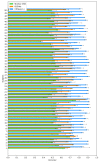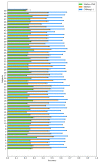Recognition of EEG Signals from Imagined Vowels Using Deep Learning Methods
- PMID: 34640824
- PMCID: PMC8512781
- DOI: 10.3390/s21196503
Recognition of EEG Signals from Imagined Vowels Using Deep Learning Methods
Abstract
The use of imagined speech with electroencephalographic (EEG) signals is a promising field of brain-computer interfaces (BCI) that seeks communication between areas of the cerebral cortex related to language and devices or machines. However, the complexity of this brain process makes the analysis and classification of this type of signals a relevant topic of research. The goals of this study were: to develop a new algorithm based on Deep Learning (DL), referred to as CNNeeg1-1, to recognize EEG signals in imagined vowel tasks; to create an imagined speech database with 50 subjects specialized in imagined vowels from the Spanish language (/a/,/e/,/i/,/o/,/u/); and to contrast the performance of the CNNeeg1-1 algorithm with the DL Shallow CNN and EEGNet benchmark algorithms using an open access database (BD1) and the newly developed database (BD2). In this study, a mixed variance analysis of variance was conducted to assess the intra-subject and inter-subject training of the proposed algorithms. The results show that for intra-subject training analysis, the best performance among the Shallow CNN, EEGNet, and CNNeeg1-1 methods in classifying imagined vowels (/a/,/e/,/i/,/o/,/u/) was exhibited by CNNeeg1-1, with an accuracy of 65.62% for BD1 database and 85.66% for BD2 database.
Keywords: brain-computer interface (BCI); convolutional neural networks (CNN); deep learning; electroencephalography; imagined speech; vowels.
Conflict of interest statement
The authors declare no conflict of interest. The funders had no role in the design of the study; in the collection, analyses, or interpretation of data; in the writing of the manuscript, or in the decision to publish the results.
Figures

















References
-
- Sarmiento L.C. Interfaces Cerebro-Computador para el Reconocimiento Automático del Habla Silenciosa. Universidad Pedagógica Nacional; Bogotá, Colombia: 2019. pp. 37–39.
-
- Han C.H., Hwang H.J., Im C.H. Classification of visual stimuli with different spatial patterns for single-frequency, multi-class ssvep bci. Electron. Lett. 2013;49:1374–1376. doi: 10.1049/el.2013.2792. - DOI
MeSH terms
Grants and funding
LinkOut - more resources
Full Text Sources

